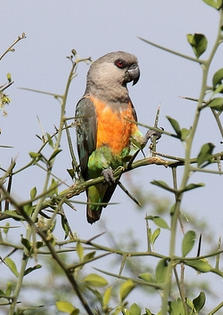Red-bellied Parrot |
|
|
Also known as: Orange-bellied Parrot, African Orange-bellied Parrot, Red-breasted Parrot, Abyssinian Parrot
Photos
View in GalleryDid You Know?
The male has a bright orange/red belly and the female's abdomen is brown/grey. This is the reverse of Rüppell's Parrot, where the female is more brightly coloured.Academic Research
Related publications: Poicephalus rufiventrisSpecies Profile
Genus: Poicephalus | Species: rufiventris
Size:
22cm (8.6 in)
Weight:
113-142g (4-5 oz)
Subspecies including nominate:
one
Colour Adult:
Male-grey/brown, with varying tinges of brown/orange on cheeks and breast; orange lower breast, abdomen and underwing coverts; pale green/blue thighs and lower flanks to undertail coverts; yellow/green rump and upper tail coverts with blue suffusion. Bill grey/black. Cere and eye ring bare and brown/grey. Eye orange/red. Female-green lower breast to undertail coverts; green rump and upper tail coverts, blue suffusion absent.
Colour Juvenile:
As in adult female, but in general paler and duller; in male orange wash on underwing coverts and breast. Cere and eye ring bare and paler grey. Eye brown.
Call:
Calls made in flight sharp and high-pitched, repeated intermittently. Also a lower-pitched, more gutteral note.
Listen NowVideo Links:
Video 1More Information:
Content Sources:
CITES
BirdLife International
Cornell Lab of Ornithology/Birds of the World
A Guide to Parrots of the World, Juniper and Parr, 1998
ML Media Collection Catalogue 138962, Red-bellied Parrot , Macaulay, Linda, Tanzania, Oct. 14 2002, Cornell Lab of Ornithology. Site
Parrots of the World, Forshaw and Cooper, 1977. 2010 edition
Parrots of the World, Forshaw, 2006.
Parrots in Aviculture, Low, 1992.
Psittacine Aviculture, Schubot, Clubb and Clubb, 1992.
Photos
View in GalleryDid You Know?
The male has a bright orange/red belly and the female's abdomen is brown/grey. This is the reverse of Rüppell's Parrot, where the female is more brightly coloured.Academic Research
Related publications: Poicephalus rufiventrisSpecies Care
Captive Status:
Uncommon
Longevity:
20-25 yrs
Housing:
Walk-in enclosure or suspended cage, minimum length 2m (6.5 ft).
Diet:
Cooked beans and pulses, boiled maize; sunflower seed, dry, soaked or sprouted; fruit such as: apple, orange, bananas, cactus fruits, pomegranates; rearing food made from hard-boiled egg, wholegrain bread and carrot, all ground to crumbly consistency; vegetables such as: carrot, celery, fresh corn, green leaves; spray millet; complete kibble.
Enrichment:
Are curious and active; provide swings, ladders and noise-makers (bells), puzzle toys, foraging toys, bird-safe wood and vegetable-tanned leather toys.
Nest Box Size:
Vertical box 12" x 12" x 24" (30.5cm x 30.5cm x 61cm).
Clutch Size:
3
Incubation Time:
24-26 days
Fledging Age:
10 weeks
Hatch Weight:
7g (0.2 oz)
Peak Weight:
Not recorded.
Weaning Weight:
Not recorded.
Photos
View in GalleryDid You Know?
The male has a bright orange/red belly and the female's abdomen is brown/grey. This is the reverse of Rüppell's Parrot, where the female is more brightly coloured.Academic Research
Related publications: Poicephalus rufiventrisSpecies Wild Status
World Population:
Unknown, stable.
IUCN Red List Status:
Least Concern
CITES Listing:
Appendix II
Threat Summary:
Not globally threatened. Uncommon in some areas, common in others in Nechisar National Park, Ethiopia. Fairly common in E Africa, including in Kenya and N Tanzania.
Range:
Somalia and S and E Ethiopia south to NE Tanzania.
Habitat:
Found between 800-2000m (2624-6560 ft) in semi-arid vegetation including dry bush areas and Acacia-Commiphora steppe woodlands. Avoids dense foliage.
Wild Diet:
Feeds on Ficus figs, Acacia seeds and ripe fruits of Balanites aegyptiaca, Cordia ovalis and Dalbergia melanoxylon.
Ecology and Behaviour:
Seen in pairs or family groups of 3-4 birds. Drinks frequently and often found near water sources. Nesting sometimes loosely in colonies, with pairs 100-200m (328-656 ft) apart.
Clutch and Egg Size:
3 rounded eggs, 27.0 x 23.0mm (1 x 0.9 in).
Breeding Season:
May–June, Ethiopia; November, January and May, Somalia; possibly June–July, E Africa, where loosely colonial. Nest is in cavity, usually in Baobab tree.
Related Links:
Photos
View in GalleryDid You Know?
The male has a bright orange/red belly and the female's abdomen is brown/grey. This is the reverse of Rüppell's Parrot, where the female is more brightly coloured.Academic Research
Related publications: Poicephalus rufiventrisMembers Only Resources
Please log-in now to find more research, resources and tools.
Not a Member?
Find more great information:
Gain exclusive access to 600+ pages of additional research, seminars and podcasts, specialists to ask your toughest questions, and dozens of other fun resources - when you become a WPT member.
Join Today >>

































